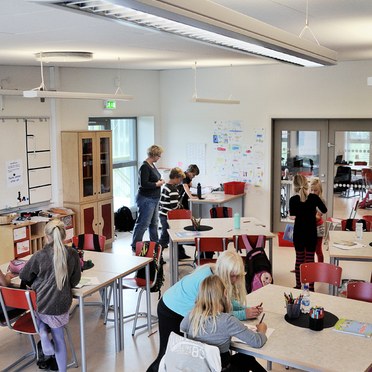瑞典EMILIA学校
- Lamp efficacy
Lamp efficacy
Ensuring the lamp efficiently converts electricity into light (lm/W).
- Ballast classification
Ballast classification
Controlling the electricity supply to the lamp (Energy Efficiency Index).
- Luminaire distribution
Luminaire distribution
Controlling light emission using optics which bend and shape the light to the correct location.
- System efficacy
System efficacy
Combining optical and thermal control within the luminaire (luminaire lm/W).
- Presence/absence detection
Presence/absence detection
Presence: Lights automatically turn on/off with movement. Absence: Lights automatically turn off and must be manually switched on.
- Daylight detection
Daylight detection
Artificial lighting which responds to the natural light conditions.
- Constant illuminance
Constant illuminance
A function designed to produce correct light levels for the duration of the maintenance period.
- Task-scene setting
Task-scene setting
Allowing the user to set scenes and adapt the lighting to different tasks.
- Timed off
Timed off
Automatic cut-off can be installed to turn all lights off during unoccupied hours.
- Task lighting
Task lighting
Lighting task areas with the correct amount of light.
- Zoning of lighting
Zoning of lighting
Lighting is zoned according to area use.
- Maintenance schedule
Maintenance schedule
Maintenance must be performed in response to product age, performance and environment.
- Waste light
Waste light
Eliminating waste light which does not hit the intended target.
- Reflectance
Reflectance
Taking advantage of light which is reflected from the surface within the space.
- Visible smart metering
Visible smart metering
Results of actions can be quickly seen as increased or decreased energy use to encourage responsible energy consumption.
使用Thorn灯具的被动式节能学校
为了实现欧盟于2020年实现能源效率增加20%的目标,Landskrona市政当局在瑞典Häljarp开设了最具能源效率的Emilia学校。除了采用具有成本效益的可持续设计方案进行建设外,建筑照明的可持续性也不容忽视。
Emilia学校是首批使用被动式节能房屋技术的教育机构之一。被动式节能房屋是指配备高度绝缘和气密性建筑围护结构的机械通风建筑,这种房屋将供暖所需消耗的能源减至最低,从而减少了生态足迹。
“被动式节能房屋”(德语为Passivhaus)这一术语是指一系列针对超低能源消耗建筑的自发性标准,由瑞典隆德大学的Bo Adamson教授和德国住房和环境研究所的Wolfgang Feist博士率先提出。
为了达到主要/源能源目标(学校的整体能源目标为
该照明方案的一大突出特点就是照明和取暖控制的结合。Thorn销售代表Bo Hall表示:“通常来说,控制房间的密度、日光和人体感应可以做到,但是在这个项目中,照明对建筑的取暖也有贡献。”
Emilia学校校长Lena Johnsson表示每个人都对出色的照明方案感到满意,这样的环境令人感到舒适。她表示:“照明解决方案虽然尚未用于帮助建筑取暖,但这只是时间问题。”

